Sprayers: Where are they made?
Unlike a number of other machinery types, British manufacturers still maintain a strong presence in the market for crop sprayers – particularly for self-propelled machines.
More than half a dozen well-known names with factories in Britain are active in the sector and continue to invest in new spray technologies, greater comfort, safety and ease of use for operators, and in better manufacturing and assembly facilities.
At the same time, these independents face stiff competition from overseas makers for both low-cost and premium sprayers, including large groups selling thousands of machines around the world.
Here, we take a look at the manufacturers selling into the British market and where they are based.
See also: Tractors: Where are they made?
Agrifac
Dutch manufacturer Agrifac Machinery has been part of the globally operating Exel Industries group since 2012.
It builds its self-propelled sprayers in a multi-million euro factory complex, which opened in 2018, at Steenwijk, about 75 miles north-east of Amsterdam.
Shared with Agrifac’s sugar beet harvester assembly operations, the facility has a high sustainability score – it has 5,000sq m of solar panels and rainwater is saved for testing sprayers and flushing toilets – and has substantial scope for increasing capacity.
Today, it produces about 300 machines annually, up from 40 units or so 10 years ago, and employees have doubled.
This is a far cry from when Agrifac built its first trailed sprayers in 1984 and its first self-propelled model in 1986, featuring the novel StabiloPlus chassis with inter-connected front and rear wheels on each side that continues to be used today.
Manufacturing of chassis, frames, tanks and booms is out-sourced to local specialists, while the cab comes from Claas and Cummins supplies the engines.
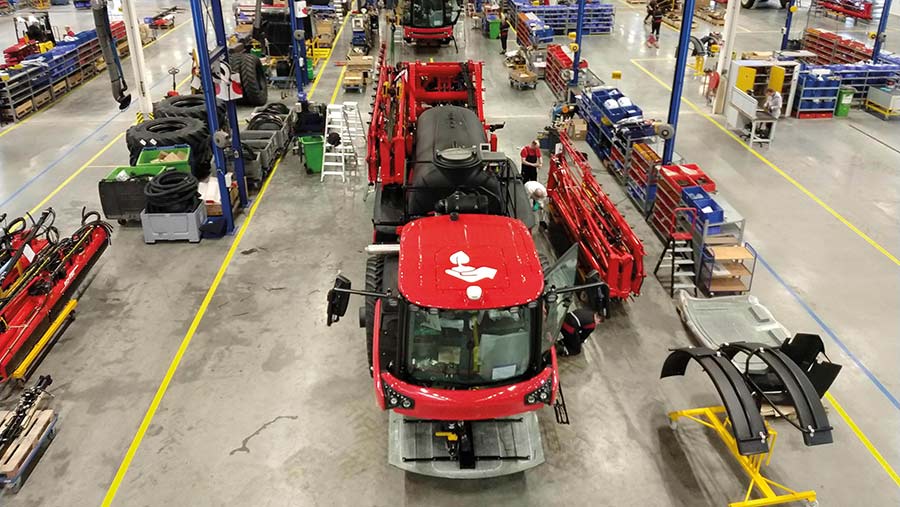
Agrifac Condor assembly line at Steenwijk © Agrifac
Amazone
Production of mounted, trailed and self-propelled sprayers is now concentrated at the new Amazone Technologie factory on a 24ha site at Bramsche, 10 miles north of Osnabruck in north-west Germany.
Work began in August 2017 on the £14m first stage of this green site development, with UX trailed sprayer assembly starting towards the end of 2018, and UF mounted models about 12 months later.
In September 2021, a £7m second-phase investment got underway with a new production hall for the largest Amazone sprayers, including Pantera self-propelled models, plus space for post-assembly testing, quality control and shipping.
The ZG trailed spreaders and Primera seed drills are also built in the Bramsche plant.
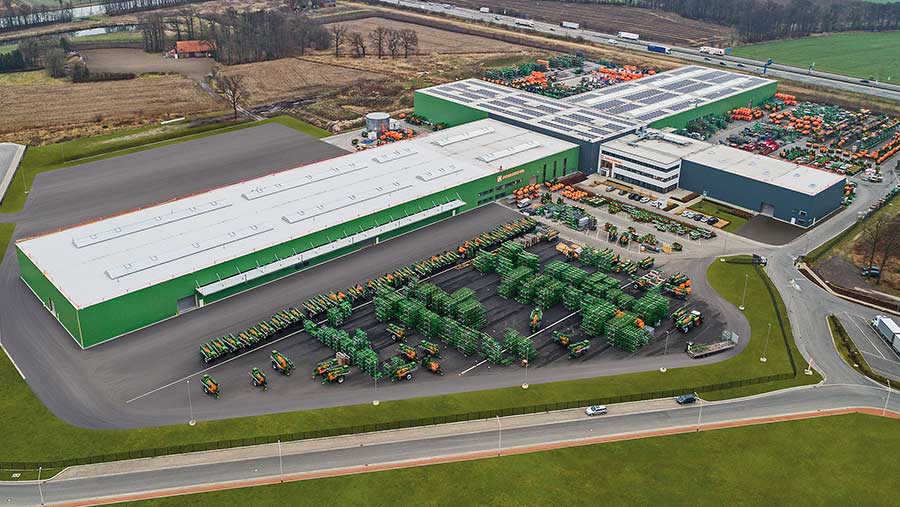
Amazone sprayer assembly plant at Bramsche, Germany © Amazone
Bargam
Italian manufacturer Bargam, whose sprayers are distributed in the UK by Merse Agriculture in the North and Severn Agriculture in the South, is part of the BGroup of agricultural equipment companies.
Its mounted and trailed models are assembled in the town of Imola, 24 miles south-east of Bologna, in a refurbished headquarters plant opened in December 2016.
Self-propelled units are put together in Jesi, 110 miles to the south-east near Ancona, on the east coast of Italy.
Bateman
From farm-based premises near Chulmleigh, Devon, Bateman Engineering operates a highly integrated process to produce a three-model range of self-propelled sprayers up to 5,600-litres capacity.
It includes in-house design of components and assemblies, manufacturing of chassis, booms, tanks, electrical looms and cabs, and also final assembly and testing.
Although specialist manufacturing such as vacuum forming is out-sourced, cab panels produced in this way are cut and finished in the factory.
By maintaining a large stock of in-house and bought-in components, production and parts, supply continued during the Covid pandemic with no reduction in the number of sprayers built, and expansion is now being planned.
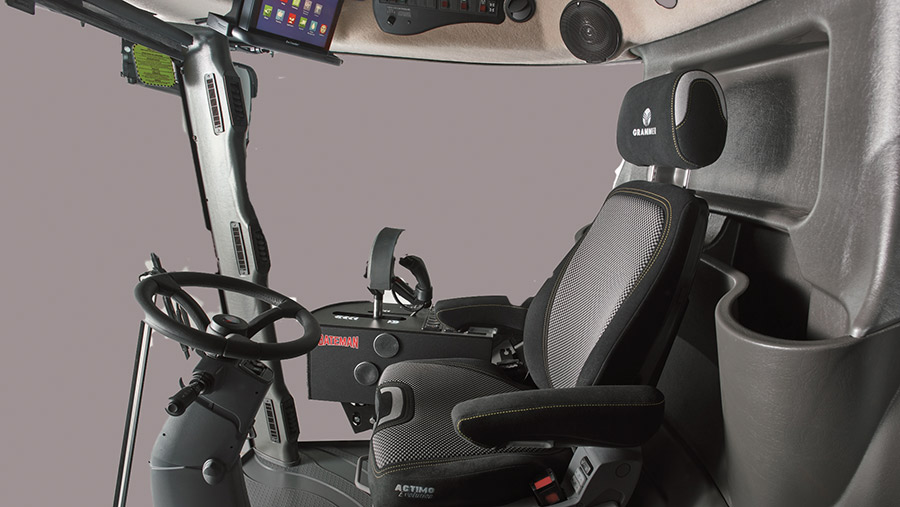
Bateman builds its own cab for the RB sprayers, © Bateman
Berthoud
See Exel Industries
Biard
The simplified “Biard” brand of mounted and trailed sprayers from Agritrend are manufactured by Polish outfit Biardzki in Zbuczyn, about 70 miles east of Warsaw.
The business started in the early 1990s and builds sprayers up to 1,200-litres mounted and 3,000-litres trailed.
Chafer
High-spec trailed sprayers up to 6,000-litre capacity and self-propelleds topping out at 5,000 litres are built by Chafer Machinery at Upton near Gainsborough, on the back of a long history (120 years, in fact) in crop application machinery, notably for liquid fertilisers.
Design and engineering development are carried out in-house, along with component manufacture such as machined parts and wiring looms.
Chassis and frame fabrication is out-sourced to Lincolnshire-based engineering firms, and stainless-steel tanks to specialist Watson & Brookman.
In 2018, Chafer brought self-propelled sprayer assembly in-house alongside the trailed machines, with cabs sourced from New Holland and engines from Deutz in Cologne.
Production and assembly of the company’s Horstine dry applicator products are also handled at the Upton site.
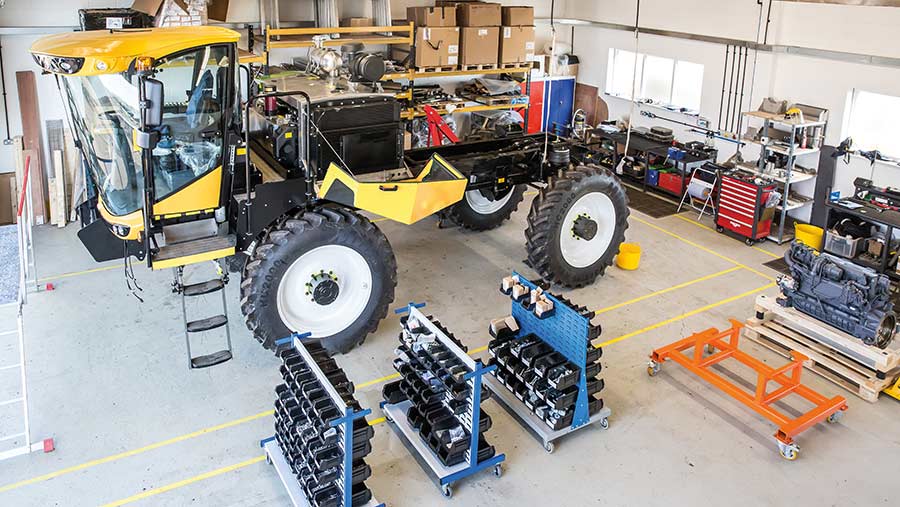
Chafer now builds its self-propelled and trailed sprayers on the same site © Chafer
Dammann
At its modern manufacturing and assembly facilities in Buxtehude, 27 miles west of Hamburg in northern Germany, Herbert Dammann builds tractor-towed and self-propelled field sprayers – including triple-axle trailed and Dammann-trac models with up to 12,000 litres capacity.
Set up in the late 1970s by farmer Herbert Dammann, the company’s 140 or so employees now also produce specialist equipment for fruit production, road and airport winter service vehicles, road-rail spraying conversions and Unimog specials.
The firm has its own test track alongside the 13,000sq m of production halls, the most recent of which was built in 2014.
Exel Industries
As the world’s largest manufacturer of crop sprayers, Exel Industries group, headquartered in Epernay in France, encompasses numerous brands.
These include the Agrifac, Berthoud, Hardi and Tecnoma products available in Britain, and Evrard, Nicolas and Matrot machines sold in other markets.
While Agrifac and Hardi continue to operate largely autonomously, in 2021 the French companies were combined under the France Pulvé banner with a single management team.
Manufacturing and assembly facilities have been rationalised, with locations such as the Tecnoma factory at Epernay, south of Reims, and Berthoud’s home in Belleville, north of Lyon, now producing components and finished products for all brands.
Self-propelled sprayer assembly for Tecnoma and Berthoud is concentrated at Fère-Champenoise, 25 miles from Exel’s headquarters, and for Hardi, Matrot and Evrard at the Hardi France operation at Beaurainville.
Mounted and trailed machine production for all brands is at Belleville and Hardi’s Norre Alslev facility in Denmark.
FarmGem
S&K Sprayers is the UK importer and distributor for Lincolnshire-based manufacturer FarmGem.
It operates a factory at Veria, 45 miles west of Thessaloniki in northern Greece producing mounted and trailed spraying equipment up to 4,400-litres capacity.
Frames, booms and chassis are designed and constructed in-house, with tanks sourced from Italian businesses.
Self-propelled units are built by Knight Farm Machinery and supplied to markets outside the UK only.
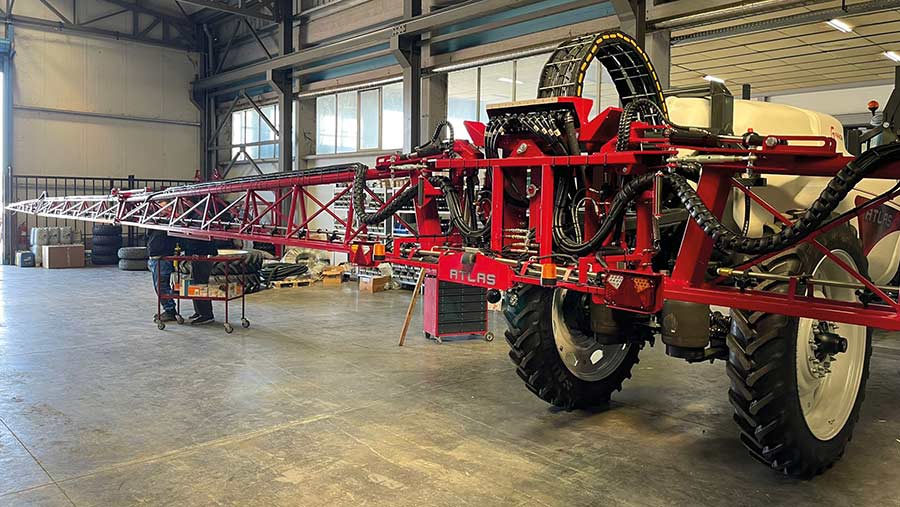
FarmGem trailed sprayer being assembled at the firm’s Greek factory. © FarmGem
Fendt
Although the single-beam chassis and plastic tanks continue to be fabricated in the Netherlands, assembly of Rogator 600 self-propelled sprayers now takes place at the Agco Hohenmolsen plant.
This also produces selected components for tractors and harvest machinery, and assembles Katana self-propelled foragers.
Located south-west of Leipzig in central Germany, the factory employs about 380 full-time staff members on a 42ha site.
It received £16m of funding in 2022 for a new paint shop and logistics centre and further capacity-related investments are planned.
Cabs and operator work stations are shipped from the Fendt factory at Asbach-Baumenheim, near the Marktoberdorf tractor plant in Bavaria, some 300 miles south.
The engine is an Agco Power unit from Finland. Aluminium booms for up to 6,000-litre capacity sprayers are sourced from Pommier in France.
Grim
A newcomer to the UK market, Italian manufacturer Grim specialises in self-propelled sprayers that are assembled in Jesi, 17 miles west of the eastern port city of Ancona.
The Series 7 GSM is built to importer Merse Agriculture’s specification, which includes hydrostatic drive through rigid axles or wheel motors, with self-levelling suspension an option.
There’s a 3,000-litre glass-reinforced plastic tank, high output pump and aluminium booms from French firm Pommier.
Hardi
Danish company Hardi International is a global manufacturer of mounted, trailed and self-propelled crop sprayers up to 5,200-litres capacity – and a member of the Exel Industries group since late 2007.
Following a reorganisation of Exel operations in France, the Norre Alslev factory in southern Denmark has become a key centre for mounted and trailed sprayer development and production (in addition to a facility in Belleville, France) across all group brands.
An interesting “green” initiative at the Danish factory sees off-cuts and sub-standard components from tank production processed into a “raw” material for moulding trailed sprayer mudguards.
Horsch
The 2011 partnership between Horsch and sprayer manufacturer Leeb has resulted in a growing position in the large trailed and self-propelled market for Horsch Leeb Application Systems.
Located at Landau, 76 miles north-east of Munich in southern Germany, the factory has expanded considerably.
The business started with 50 employees and now has about 500 on the assembly site and at a welding facility in Oberpöring half a dozen miles away.
Chassis, tanks and booms are manufactured in-house, and the cab is sourced from Claas.
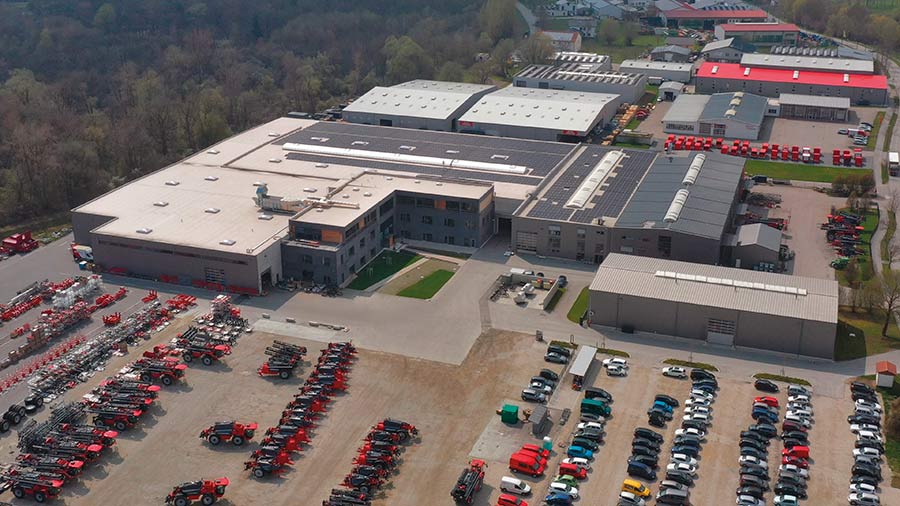
© Horsch-Leeb sprayer production capacity has grown substantially © Horsch
Househam
Specialising in self-propelled sprayers, Househam’s history dates back to the 1970s with tractor-based models before switching to purpose-built machines in the late 1980s.
Originally based in Leadenham, Lincolnshire, the company moved to the former SprayCare premises at Woodhall Spa in 2019 – a business making mounted and trailed sprayers acquired by Househam in 2005.
SprayCare products were manufactured in Hungary under the Househam name until that operation closed.
Today, the company is dipping its toe into the overseas market for small, economical trailed sprayers with machines produced at Woodhall Spa once more.
Extended buildings provide double the assembly area and increased warehousing capacity for pre-owned and service activities, with neighbouring fields used for on-site testing.
The four-model Househam product range – Spirit, AirRide, Harrier and Predator from 3,000-5,000-litre capacity – are assembled with booms, smaller items and some axles fabricated on-site by former employees, and larger items by a specialist in Lincolnshire.
GRP and stainless-steel tanks are out sourced locally, while cabs (Claas) and engines (MTU) come from Germany.
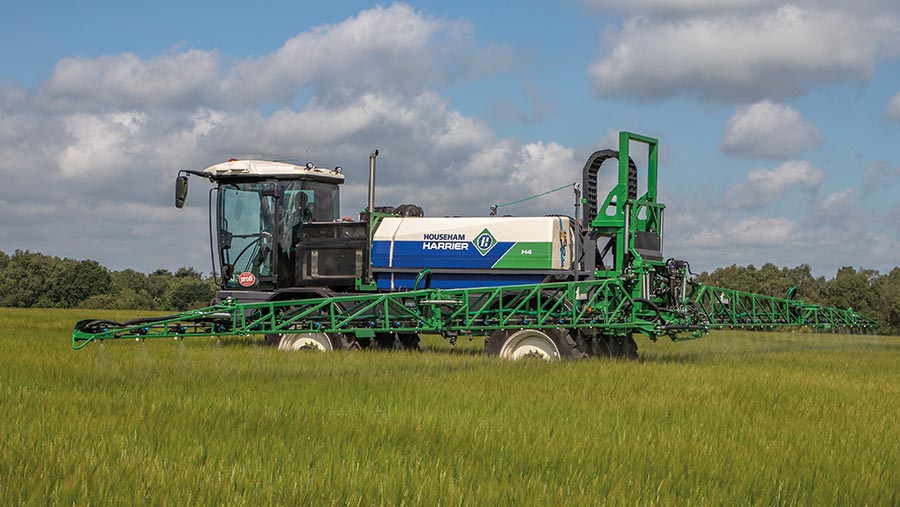
Mid-range Househam Harrier at work © Househam
Jar-Met
Tractor mounted and trailed sprayers are built by Polish manufacturer Jar-Met at Wegrów, 60 miles east of Warsaw, as part of a portfolio of numerous farming implements.
Three dealers – Eric Townend Farm Machinery, TH Jenkinson and AR Harries – distribute the sprayers in Britain.
John Deere
Since Deere & Co acquired sprayer manufacturer Douven and its factory at Horst, southern Netherlands, for its first foray into the European crop care market, the facility and John Deere product range has grown in scale, sophistication and sales volume.
The Horst plant produces trailed sprayers up to 7,500-litres and the R41 self-propelled models up to 5,000-litre capacity (or as a chassis-cab unit), using components sourced from John Deere’s worldwide production facilities.
These include engines from Deere Power Systems at Saran in France, cabs from Ramos in Mexico, and spray controllers, displays and GPS equipment from JD facilities in North Dakota and California in the US.
The booms are made at Horst, while chassis frames and spray solution tanks are designed in-house, then out sourced to specialists.
In the past five years, the plant has gained additional parts warehousing, workshop and office space for the product engineering and quality departments.
Knight
Knight Farm Machinery produces the widest range of any British manufacturer, with a full complement of front and rear linkage and deck-mounted tractor sprayers, and trailed and self-propelled machines up to 6,000-litre capacity.
It also exports purpose-designed products to New Zealand, Japan, Israel and Belgium.
The company’s premises at South Luffenham, near Oakham, Rutland, have been home to the operation since its inception in the 1980s.
It has recently been equipped with a new CNC-controlled brake press, machining centre and milling machine, as well as a large laser sheet metal cutting installation to reduce reliance on outside suppliers.
Booms and chassis are designed and manufactured in-house but to meet flexibility requirements rotationally-moulded tanks are sourced from Italy, while GRP and stainless-steel tanks come from British specialists.
As many other components as possible are sourced from local suppliers, including engines from Perkins at Peterborough, but cabs are from Claas in Germany.
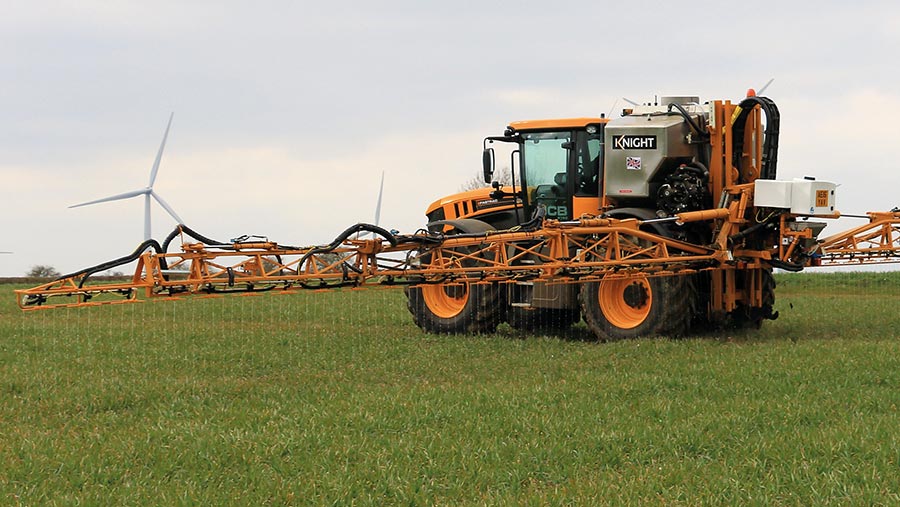
Knight Farm Machinery’s Deck-mounted sprayer on JCB Fastrac © Knight Farm Machinery
Kuhn
An initial foray into crop protection machinery with the 1996 acquisition of Nodet in France blossomed in 2008, with Kuhn’s bigger and more comprehensive Blanchard range built at Chaumes-en-Retz on the west coast of France.
Tractor-mounted and small capacity trailed sprayers, such as the Lexis, continue to be assembled there.
However, production of larger capacity trailed models like the Metris with up to 4,100-litre tanks is at Kuhn Group’s manufacturing headquarters at Saverne in north-eastern France, about 25 miles from Strasbourg.
Having bought sprayer specialist Artec Pulverisation in 2016, Kuhn has a facility for self-propelled sprayers at Corpe, south of Nantes in the west of France, and also the Montana operation in Brazil, acquired in 2014, but neither plant supplies products to Britain.
Kverneland/Vicon
Design, engineering development and manufacture of most steel parts for Kverneland and Vicon front-tank, rear-mounted, trailed and self-propelled sprayers takes place at Kverneland Group’s Nieuw-Vennep factory in northern Netherlands.
Situated 20 miles south-west of Amsterdam, the site is also the home of Kverneland’s Mechatronics business unit producing isobus electronics hardware and software, including the IsoMatch Tellus range of universal terminals used with the sprayers.
A £1.05m dedicated assembly line was installed for the iXtrack T-series trailed sprayers of up to 7,400 litres, with regular investments made in production and assembly resources at the plant, not just for increased capacity but also to improve ergonomics.
For example, boom assembly pillars and two hydraulic jigs that rotate the sprayer mainframe sideways enable workers to stand upright for most processes.
Steel and aluminium spray booms are built in-house, while tank production is out sourced to specialists. The self-propelled chassis/cab comes from Mazzotti.
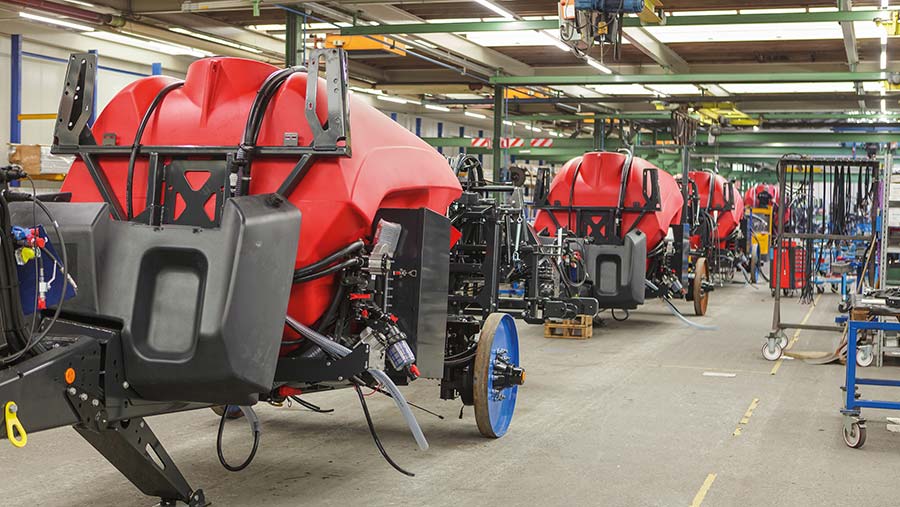
Kverneland and Vicon iXtrack assembly line at Nieuw-Vennep © Kverneland
Landquip
Premises on the outskirts of Fressingfield, Suffolk, are home to the Landquip sprayer range, which covers everything from compact tractor models to a high-clearance self-propelled.
The core product line encompasses four models of trailed sprayers in sizes up to 6,000 litres with different levels of specification and features, including the PowerTrac with driven axle.
Design and engineering are in-house, along with fabrication of the frames and chassis for the mounted and trailed models.
Self-propelled variants are based on a Househam power unit with Landquip spray equipment, and the Landquip-spec aluminium booms fitted to all the company’s agricultural sprayers come from Pommier in France.
GRP tank production is outsourced to a specialist in Norfolk, and the polyethylene versions come from Italy.
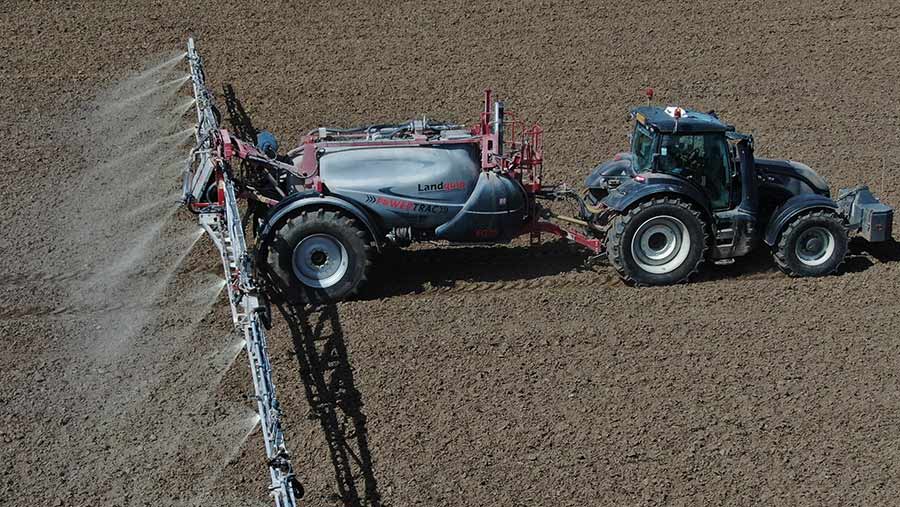
Landquip’s PowerTrac driven axle trailed sprayer © Landquip
Lite-Trac
Specialising in high-capacity vehicles for crop spraying, liquid fertiliser and dry product boom application, Lite-Trac Products is based at Holme Fen, near Peterborough, where the substantial mid-engine chassis and novel tipping applicator frame are fabricated.
Aluminium booms up to 48m wide, from Pommier in France, are fitted along with out sourced stainless-steel tanks up to 8,000-litre capacity.
The in-house designed granular product boom is an alternative to the spinner spreading body, carrying up to 5.6t of fertiliser or 12t of lime.
The 260hp engine is shipped from the Cummins plant in Darlington, while the cab comes from New Holland. A new model – the LTV3000 – is promised for 2023.
Mazzotti
Since becoming a wholly-owned subsidiary of John Deere in mid-2017, Italian self-propelled sprayer manufacturer Mazzotti has adopted more Deere components and technology.
The “Mazzotti by John Deere” machines are built on the outskirts of Ravenna, east of Bologna, with engines from Saran in France, a cab from Ramos in Mexico.
Spray controller, displays and GPS equipment are sourced from Deere facilities in North Dakota and California, US.
Fabrication of the in-house designed chassis and solution tanks is out sourced to specialist suppliers, and in addition to some improvements in production equipment, recent upgrades comprise a quality test area and an R&D test track.
McConnel
Production of the Agribuggy self-propelled sprayer moved from Gloucestershire to the Alamo Group Europe site at Salford Priors near Evesham, Worcestershire, in 2018 when Kellands was incorporated into McConnel.
Significant investment went into a new production area and manufacturing tools as previously out sourced processes were brought in-house.
This included all steel fabrication for chassis, cabs, engine frames and small bracketry, in addition to final assembly and testing.
The larger 3,000-litre GRP tank of the latest AB300 model is out sourced locally, while aluminium booms come from Pommier in France, the gearbox from ZF in Germany, and axles from Omsi in Italy.
The engine, previously shipped by Cummins from China, is replaced by a larger 3.8-litre motor from the Cummins plant in Darlington.
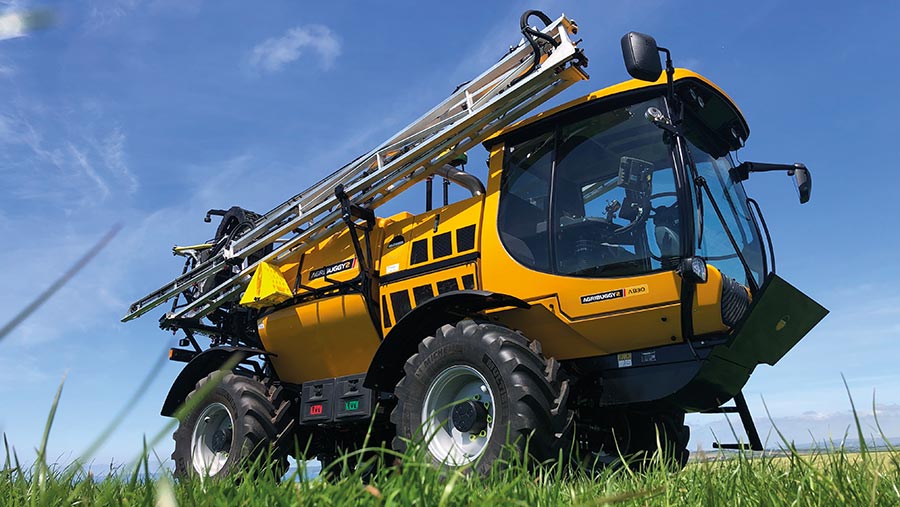
Former Kellands Agribuggy is now a McConnel product © McConnel
Sands
With the business starting in 1973 as an offshoot of a contracting operation, Sands Agricultural Machinery celebrates its 50-year anniversary in 2023, with on-going production of Horizon and new Infinity self-propelled sprayers up to 6,000-litres.
Plans are afoot for the firm’s most ambitious investment yet – a shift from the facility at Brunstead, 15 miles north-east of Norwich, to a new multi-million pound factory 10 miles away that will be triple the size.
This will provide more space for production, paint shop capacity, and larger service bay and stores.
Office space will be increased for in-house training and design, and shot-blasting will be brought back into the fold, simplifying logistics and complementing the chassis and boom manufacturing processes.
Production of GRP and stainless-steel tanks will continue to be out sourced to UK-based specialists, and the Sands-designed Panoramic cab manufactured in Germany, where the Deutz engines are also sourced.
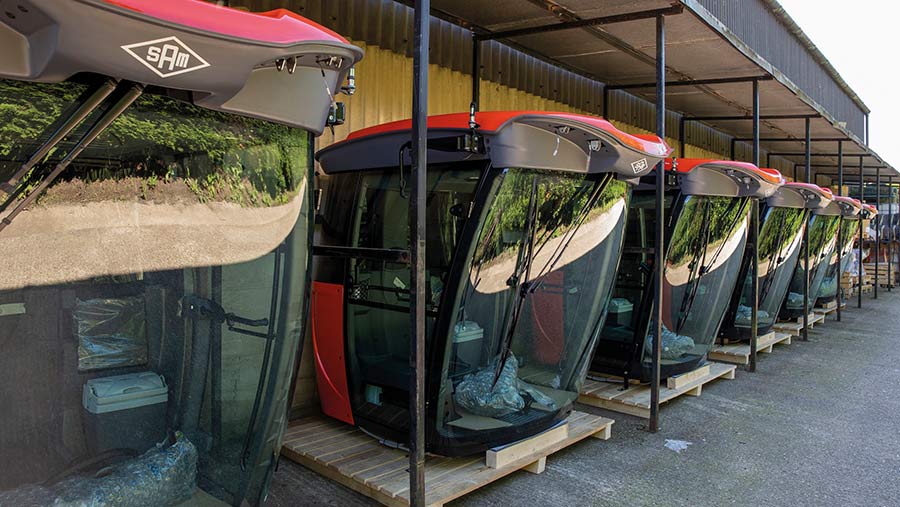
Sands Agricultural Machinery is constructing a new factory for its SAM sprayers © Sands
Team
Formed in 1981 by ex-employees of the Dorman Sprayers company after it closed, Team Sprayers, based at Witchford near Ely, continues to specialise in groundcare and both mounted and trailed sprayers up to 5,000-litres.
Machines are built to order, which enables final specification to suit differing requirements.
While the UK remains the principal market, numerous distributors overseas points to welcome exports demand.
Growing sales in recent years led to an investment in a factory expansion that provides increased assembly capacity and a more efficient production flow through the facility.
There is also an outside space for testing and storage of larger sprayers.
More investment is planned to further grow the business.
Tecnoma
See Excel Industries.
Tolmet
Described as a “decent quality budget sprayer” by distributor Agritrend, Tolmet sprayers are produced in Swinice Warckie, about 110 miles west of Warsaw.
The business builds trailed models but only the tractor-mounted range is available in Britain.
Vicon
See Kverneland.
